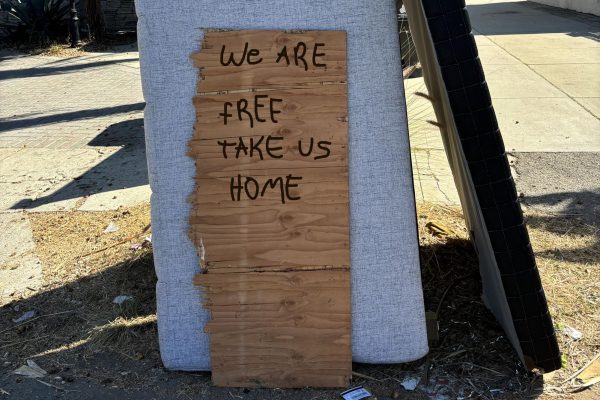Seeking justice: LA attorneys, judges discuss bias in system, ways to address it
Photo credit: Sydney Tilles
This WordCloud depicts students’ and faculty members’ responses when asked the question, “What are three words that come to mind when you think about our justice system?” Attorneys and judges described what they see as the underlying biases in L.A.’s justice system and how they are working to combat them. (Graphic Illustration by Sydney Tilles)
Unfair. Biased. Unjust. When The Oracle sent eighth through 12th grade students and faculty members a survey focused on the justice system and asked respondents which three words came to mind when they think about L.A.’s justice system, these were the three most common words.
Although only 35 of 518 people surveyed responded, these words suggest at least some in the Archer community question the fairness of the system. Some students and faculty suspected bias within the judicial system.
According to The Leadership Conference on Civil and Human Rights, analysts cite mandatory minimum sentencing as an example of bias in judicial sentencing. This bias existed in the disparate sentencing for crack cocaine and powdered cocaine, which are the same drug. Crack cocaine has a lower price and is easier to produce and distribute, which makes it widely accessible to poor communities, many of whom are minorities. With a previous ratio of 100:1 sentencing disparity between crack and powdered cocaine, the mandatory minimum sentence for five grams of crack is five years, while the powder carries the same mandatory sentence for 500 grams of cocaine.
Christen Sproule is a criminal prosecutor who attended Cornell University for her undergraduate degree and Georgetown University for her law degree.
“Crack cocaine is typically used more by minorities, whereas powder cocaine is often used by more wealthy people, who are often white,” Sproule said. “The Department of Justice voluntarily went and reviewed all of these sentences for crack cocaine. We got those sentences lowered to be proportionate to the powder cocaine, and so that was certainly an instance where there was unfairness.”
In 2022 Attorney General, Merrick Garland corrected the cocaine sentencing disparities since he said it caused unwanted racial disparities in sentencing. Now it is down from 100:1 to 18:1. This is one example of how the justice system is growing to correct its previous mistakes.
However, the disparate sentences related to cocaine are not the only example of bias within the judicial system. The Sentencing Project is an organization that advocates for effective responses to crime that minimize imprisonment and criminalization. According to the Sentencing Project, Black youth are four times as likely to be detained or committed in juvenile facilities as their white counterparts.
According to NAACP, a Black person is five times more likely to be stopped without cause than their white counterpart. Merely 5% of illicit drug users are Black, yet Black people represent 29% of those arrested and 33% of those incarcerated for drug offenses.
Sproule said she makes a strong effort to carry out justice and will only take cases where she knows that the defendant is guilty. She said that to keep her and her coworkers’ implicit bias in check, they have a “blind charging” system, where the people who are charging the criminal do not know certain identifying information about that person, which helps prevent racial profiling.
“It’s a flawed system. Unfortunately, that’s absolutely true,” Sproule said. “It’s a hard problem to fix, especially when you want to have a safe society, but you have to balance that against being equitable.”
Emily Gray is a history teacher and ninth grade dean at Archer. Before she became a teacher, she was an attorney. She was a history major in college and said she has always loved studying government. She said that although the outcomes of the cases she tried were not necessarily prejudiced, she felt that there was discrimination behind the scenes.
“When you are in your early twenties, and you’re fresh out of law school, you have this idea of, ‘Oh, I’m going to go change the world.’ And then you get into the reality and realize that it’s easier said than done, especially over the past five years in this country,” Gray said. “I have grown very skeptical of the systems in this country. Not to say that I don’t think we can overcome some of these challenges, but it’s been the most challenging time in terms of the threats to our democracy and the justice system and whether justice is carried out or not.”
Los Angeles District Attorney George Gasćon said he is committed to and working towards community safety and making the legal system more fair for everyone.
“We are very heavy into the punitive side of our work. We have traditionally viewed punishment as being equivalent to fixing the problem,” Gasćon said. “We pay very little attention to rehabilitation. We think that the best thing that we can do for the victim is to punish the offender — often not dealing with the underlying trauma that was caused to the victim.”
Gasćon said that when looking at the Los Angeles prison population, approximately 80% of men and 90% of women have been victims of crimes in their youth. He said this statistic speaks to the failure to resolve the problem for the victims. Therefore, by not addressing the underlying trauma, the victim will victimize others. He added that within three years of when an inmate is released, they are 50% more likely to re-offend than people who have not been previously incarcerated.
“When we have things like life sentences, there are some people who are so dangerous that we really don’t want them on the street with us anymore,” Sproule said. “But, in particular, drug addiction is a problem someone can have that can drive criminal behavior. Just taking someone who’s a drug addict and putting them in prison is not going to solve their problem, [and it is] the same thing with mental illness.”
Gasćon said that although there are different systems in place to try to mitigate the harm caused to minorities and intentionally to fight against bias, they are often ineffective.
One of Gasćon’s goals is to reduce the harmful impact of law enforcement on vulnerable communities, such as the death penalty. The L.A. County District Attorney’s Office has made a point to stop seeking the death penalty since it has almost been exclusively used against minorities. One in eight people who have been executed by the death penalty have been innocent.
Additionally, Gasćon aims to be more thoughtful about how he deals with juveniles. Currently, he is trying to minimize the impact of criminalization by diverting people to other programs like rehabilitation centers rather than prisons.
“Taking someone who’s mentally ill and putting them in a prison cell is not going to help anybody,” Sproule said. “There has been a lot of focus on having more programs available for the mentally ill and people who are addicted to drugs to try to solve those underlying problems so that they are able to get their lives together and be better people.”
Gasćon plans to bring together the L.A. residents and law enforcement by educating people on the legal system and help them understand that although imprisonment is a component of the system, it is not the first resort.
“As a prosecutor, we don’t control probation, we don’t control prisons, we don’t control parole. So, we’re always having to work to influence a process by gaining the support of others that may or may not always agree with us,” Gasćon said.

Victoria B. Wilson is a judge for the Los Angeles County Superior Court, and she was appointed by Governor Jerry Brown in 2017. As a preliminary court judge, she rules on 70 – 100 cases a day. She said no matter how many cases she has, she is thorough and makes sure every single person has a fair hearing.
Wilson has multiple techniques to reduce her implicit bias. She takes pride in approaching every case with empathy and respect. When the alleged criminal enters the courtroom, she said she always looks them in the eye, says good morning and addresses them as Mr. or Ms. She said, although it might seem insignificant when they have been imprisoned in inhuman conditions, a simple “hello” and “good morning” can go a long way.
Gray agreed it is important to treat people with dignity and respect.
“It is important to understand inherent racism within the system because when we see the types of people who are being sentenced and sent to jail, there is sometimes a certain profile,” Gray said. “I think people have the wrong perception of causation. The causation is because the system is broken, not the people that are broken.”
Wilson said she uses logic to analyze the circumstance but empathy when delivering the verdict. She said if the suspected criminal is not a danger to society, there is no reason for them to be locked away. Then, she will allow bail, but she asks the alleged criminal what they can pay. She knows granting bail disproportionately affects minorities since they are more often not able to afford it. When she grants bail, she sets it high enough that the offender will return to court but low enough where they can pay it and rejoin society.
The final factor Wilson takes into consideration is whether they are a part of the LGBTQ+ community. LGBTQ+ people are more likely to be attacked while incarcerated. Therefore, Wilson said she will particularly try not to have them incarcerated unless they are a major societal threat.
Although they agree prejudice influences the legal system, people like Sproule, Gasćon and Wilson say they are attempting to fight against these inherent biases and make the system better for everyone. Gasćon and Gray emphasized how education about these system issues is crucial for improving the justice system.
“Sometimes, if the legal system is not doing their job, I think sometimes this is the role of the legislature to come in and pass a law,” Gray said. “That’s why we have checks and balances in this country. You can have another branch being like, ‘You are not doing your job, so we’re going to step in and do it for you.’ And sometimes, I think that’s necessary.”

Sydney Tilles joined the Oracle as a staff reporter in 2022, became a senior reporter in 2023 and is the outreach editor for 2024. She loves learning about...








